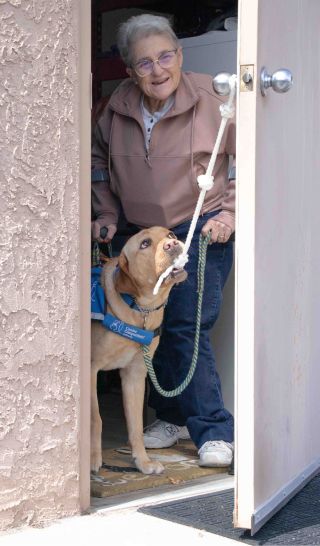Anxiety
How a Dog’s Journey Is Helping Hundreds of People
The story of Mara the dog and Betsy the human.
Posted March 24, 2023 Reviewed by Tyler Woods
Key points
- Studies show that owning a dog can decrease anxiety and depression as well as improve cardiovascular health.
- The story of Mara the dog and Betsy the human reveals how by helping one person, a dog can help hundreds of people in a compounding effect.
- "Don’t worry about what you cannot do, worry about what you can do," says Betsy.

Because my husband and I love dogs so much, we went to a non-profit Canine Companions dog graduation event in San Diego last February. That's where we met Betsy, the human and Mara, the dog. Mara had just completed her final training as a service dog and was ready to go to her new home with Betsy. We were impressed by Betsy and Mara's story and decided to interview them.
The story of Betsy, the human:
Betsy’s dream of helping the disabled was threatened by her own disability. A few months ago, Betsy became more afraid of losing her balance, of falling when alone, of being unable to get up and get help, of breaking more bones than the more than 100 she'd already broken in her 59 years of life.
Would Betsy have to stay home for safety because her body was failing her? Would she have to stop her job as a counselor for people with disabilities? Would she have to stop going to see friends and do fun activities? She had to find a solution to keep her independence while feeling safe.
Betsy had fought so much in the past years to preserve her independence. She was born with a condition called osteogenesis imperfecta, also known as brittle bone disease, which means that her bones would easily break throughout her lifetime for no apparent reason.
Indeed, Betsy’s first broken bone was when she was six weeks old, and since then, she has broken more than 100 bones. Betsy spent most of her childhood in a body cast and was placed in traction six weeks at a time in a hospital where her parents could only visit her once a week for four hours. Every summer, Betsy needed some kind of rod in one of her bones and as a result, she grew up with braces and crutches.
But when her doctors told her she had to wear braces and use crutches for the rest of her life, she refused. When her doctors recommended that she not get pregnant nor adopt any infant, there also, she refused, got married to a wonderful man, and adopted two beautiful boys, one of them an infant.
Today, she had to keep on fighting. But how? What could she do to protect herself?
She decided to contact the non-profit organization Canine Companions and apply for a service dog.
A few months later, she was introduced to a dog called Mara.

The story of Mara, the dog:
Mara, a female yellow lab, was born two years ago and was selected at the age of two months to be trained as a service dog because she was very sweet, very attentive to humans, already following commands, and always willing to help.
After 18 months of training by Canine Companions, Mara learned close to 40 commands. Then she went through an additional six months of more intense training. At the end of that intense training, Mara was placed in the presence of 15 different humans who had requested a service dog.
One of those 15 humans was Betsy, and as soon as Mara locked eyes with Betsy, Mara wagged her tail—which she hadn’t done as much with the other people. Betsy immediately knew that Mara would love her and protect her, and it seemed that Mara knew that Betsy would equally love her and protect her.
How Mara the dog is helping Betsy, Betsy’s husband, and Betsy’s clients:
Betsy and Mara have been together since February 10th of this year and Mara has already changed Betsy’s life.

Mara always keeps an eye on Betsy. As soon as Betsy needs her, Mara is ready to get up and help, which triggers a lot of praise from Betsy and makes Mara incredibly happy, judging by how much she wags her tail. Mara senses Betsy’s emotions and will do everything she can to make Betsy happy. As Canine Companions’ trainers say: “Your emotions go down-leash.”
Mara brings her leash when it’s time to go out and she opens doors for Betsy.
When Betsy walks in the streets, she feels much safer now that Mara is with her. First, people give her more room. Also, if one of Betsy’s crutches falls on the ground, Mara picks it up in her mouth and gives it to Betsy.
At the office, Mara brings Betsy a can of soda when Betsy or one of her clients is thirsty.
At home, when the laundry basket is full of clean laundry, Mara pulls the laundry basket from the laundry room to the bedroom while walking backwards in the corridors so that Betsy can put the clean clothes away in the bedroom.
Mara and Betsy watch TV and cuddle every night. Betsy says: “It is Mara's favorite time of day. She is just a real love bug, and her joy and happiness are contagious.”
But the most important thing is that if Betsy falls, Mara helps her get up or calls for help if help is needed.

Betsy says: “Mara allows me to keep my independence and feel safe. With Mara by my side, I can continue to get out of my house, meet people and be happy.”
It seems that Mara has found her purpose in life: looking over Betsy.
As a result, Betsy can continue to do the work that is her own purpose in life: serving as a counselor for people with disabilities who have anxiety and depression. Betsy sees clients in her office and goes to group homes on a regular basis. Betsy helps handicapped people find their own purpose in life.
“You don’t have to let your disability be a disability. Don’t worry about what you cannot do, worry about what you can do,” Betsy said.
When Betsy’s clients are anxious and depressed and don’t want to talk to her, Betsy sends Mara (with the command “visit”). Mara puts her head on the client’s lap and the client often ends up confiding in Mara.

Betsy tells her clients: “Don’t be afraid to dream. Don’t give up. Everything is possible if you believe in yourself.”
Having Mara by her side has given not only Betsy, but also Betsy’s husband, more peace of mind. He can now go hiking or fishing and leave Betsy in the care of Mara.
Betsy isn’t alone in finding help from a dog.
What studies show:
Studies published in Clinical Gerontologist show that owning a dog can decrease anxiety and depression as well as improve cardiovascular health.
Additional research published in the 2021 Journal of Occupational Rehabilitation, shows that having a service dog improves the ability of people to travel to work and lowers absenteeism.
But Betsy’s story shows how a dog not only improved her owner’s ability to travel to work, but also is changing her new owner’s life as well as changing hundreds of other people’s lives in a cascading effect. It all as to do with finding a purpose in life.

Conclusion:
It seems that Mara the service dog found her purpose in life in helping Betsy, which allowed Betsy to continue her own purpose in life: helping hundreds of people with disabilities find their own purpose in life.
As Mark Twain said so well: "The two most important days in your life are the day you are born and the day you find out why."
So, what about you? What is your purpose in life? Are you living your life fully and happily with purpose or are you afraid to dream? If you are afraid to dream, remember Betsy’s teaching: “Everything is possible if you believe in yourself.”
Copyright 2023 @Chris Gilbert, MD, Ph.D.
Published with Betsy's permission and with Canine Companions' permission.
References
Does Dog Ownership Affect Physical Activity, Sleep, and Self-Reported Health in Older Adults? By Eliska Mickova and colleagues. International Journal of environmental Research and Public Health. 2019
Companion Animals and Health in Older Populations: A Systematic Review by Michael J. Hugues and colleagues, Clinical Gerontologist, 2019
A Scoping Review of the Benefits and Challenges of Using Service Dogs for Finding and Maintaining Employment by Sally Lindsey and colleagues, Journal of Occupational Rehabilitation, 2021




